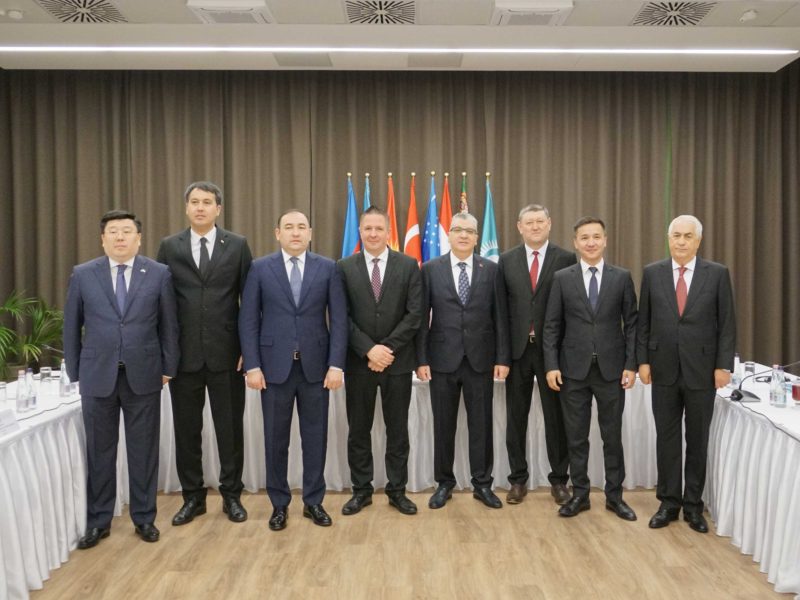Sultan Raev, the Secretary General of the International Organization of Turkic Culture, who is paying an official visit to Hungary, participated in the ceremony in the Hungarikum Grove in Lakitelek of the unveiling of the statue of Sayakbay Karalayev, the bard of the ancient Kyrgyz epic Manas. The Secretary General of TÜRKSOY paid a visit to the Petőfi Camp of Fine Arts and several other cultural memorials in the region.
The bronze bust made by sculptor Györgyi Lantos has been placed in the Hungarikum Grove in Lakitelek. In the Kyrgyz traditions the central position is occupied by the epic trilogy Manas. The singers performing the epics are the Manas singers, called in the Kyrgyz language Manaschy.
Sayakbay Karalayev was born in the region of Issyk-Kul in 1894. He was blessed with an excellent memory, and was familiar with the national Kyrgyz folklore. It was between 1935 and 1937 that folklorists in Kyrgyzstan recorded a variant of the Manas trilogy recited by him. Later he added further episodes to it, which makes the trilogy twenty times longer than the ancient Greek Iliad and Odyssey. This is the reason why Sayakbay was called the Homer of the nomadic world of Central Asia.
During the unveiling of the statue Sultan Raev said that the ceremony recalled the common roots, history and fate of the Hungarians and the Kyrgyz people living thousands of kilometers away. He emphasized that the roots of the two nations are not splitting and will one day reunite our peoples. He called the statue a historical memorial that expresses the respect of the Hungarians for the Kyrgyz people.
In his speech László Kövér, the Speaker of the Hungarian Parliament said that memories create common values, and in such a way communities. They place people side by side, and connect the generations. As the Speaker put it, “If one people is able to preserve its ancient epic for a thousand years by its heroes – bards, passing it by word of mouth from one generation to another without literacy, this people can be called a great power – the great power of memory.” László Kövér also added that such a great power “makes everyone that it meets accept the passion for memories” with respect. Everyone is and will be in great need of this passion, especially in the Western parts of the world where killing memories already possesses a name. It is called cancel culture that is the culture of deleting memories.”
The statue of Sayakbay Karalayev “should profess to everyone in Hungary that we have relations living far in the East, the Kyrgyz people that have survived because they have preserved their memories, as well as their national epic, the Manas that will in turn preserve the Kyrgyz nation for the next thousand years,” said the Speaker.
Suiunbek Kasmambetov, the State Secretary of the Republic of Kyrgyzstan pointed out that for their people Manas is a kind of encyclopedia, a kind of Act of the State that has registered the history of the Kyrgyz people and their traditions. Against the challenges of today, the next generations must not only preserve what is said in the epic but hand it down as well. The unveiling of the first ever statue abroad of Sayakbay Karalayev, the Kyrgyz bard will further strengthen the development of the relations between the Hungarian and Kyrgyz people which have already been manifold. The State Secretary expressed his special thanks that the unveiling of the statue was scheduled to be close to August 31, the Day of Independence of the Republic of Kyrgyzstan.
Sándor Lezsák, the Deputy Speaker of the Hungarian Parliament, the Chairman of the Advisory Board of the Foundation of the People’s College stressed that it was in the Hungarikum Grove, in the Christian Pantheon in front of the Saint Stephen Chapel that the Hungarian high priests, the martyrs and the confessors of the 20th century have been placed. On the other hand, it is the National Pantheon in front of the House of Kölcsey that has been designated for the people that have formed the ethos of Lakitelek in the course of the past centuries.
The Deputy Speaker also underlined that around the tombs of our ancestors who have immortalized the memory of the people who populated the former Avar settlement “the Pantheon of the people related to the Hungarians” is already being formed. The statues of personalities are placed here who had in one way defined the history of the given people, its way of thinking, even its place in the world. The first statue was the bust of the Kazakh poet, Ibrahim Abaj Kunanbajuli. The area surrounded by the riding hall, the camp of yurts and the tombs of the ancestors present a unique environment for the bard of the Manas too, added Sándor Lezsák.

